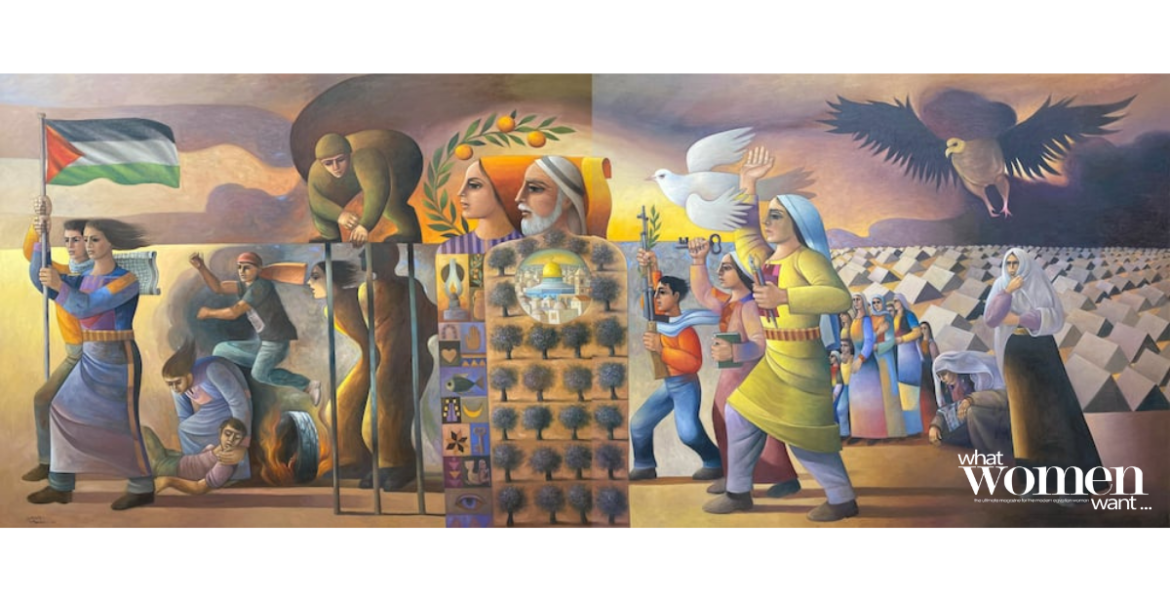Symbolism has always been a way to cleverly tell a story, convey an idea, and reinforce identity. In the face of oppression, Palestinians have turned to symbols to voice their patriotic feelings toward Palestine. In fact, each symbol is able to summarize its conditions and political state. The ongoing struggle Palestinians live through made them turn to symbols to express their suffering. While censoring is at an all-time high, the public must know and acknowledge the symbols of Palestinian resistance and the stories behind them.
Olive Tree:

The olive branch is a universal symbol of peace, but it has a distinctive place in the hearts of Palestinians. It encapsulates the Palestinian identity, as it is native to the land and symbolizes resistance against the illegal settlers. The olive tree provided economic prosperity for Palestinians, but the connection to it that reaches further than financial gain. It is an integral part of the Palestinian diet and cuisine, as olives and olive oil are used in every meal. Palestinians also used olive oil in oil lamps and moisturizer for their hair, nails, and skin. The leaves and the branches were used to feed the sheep and goats. To this day, Palestinians have an untethered connection to the olive tree and their land.
The Watermelon:

Before the Nakba in 1948, Palestine was known for their world-famous succulent watermelons. As Israel started occupying thier land, settlers brought their own seeds and replaced native crops. In years following the Six Day War in 1967 flying a Palestinian flag became punishable by law. Any outward show of the flag would result in impressment or even worse. To rebel against the ban, Palestinians began to carry sliced watermelons through occupied Gaza and the West Bank. With its colors mirroring the Palestinian flag, it became a symbol of resistance. Now, a new tradition has emerged uniting Palestinians and drawing influence from their ancestors who fought in the late 20th century.
The Palestinian Keffiyeh:

The Palestinian Keffiyeh is a black and white checkered, square in shape -120cm x 120cm- with fringes amongst its edges. It is an essential part of the nation’s identity as it represents a long history of struggle. It gained international popularity amongst activists in solidarity with Palestine. The Keffiyeh design consists of a fishnet pattern, bold lines, and olive leaves. The fishnet pattern symbolizes the native’s connection to the sea. Another common interpretation linked the pattern to collectivism, knotting individuals into wider and stronger entities. The bold lines represent the barbed wire, a nod to the nation’s occupation. The olive leaves symbolize Palestinian land and economy. Today, the keffiyeh plays an important political and social role in national celebrations, songs, and weddings.
Handala:

Handala is a national symbol and personification of the Palestinian people. He is the creation of the Palestinian political cartoonist Naji Al-Ali and first appeared in Al-Seyassah in Kuwait on July 13th, 1969. The name comes from the Arabic Name of the Citrullus Colocynths, a native plant to the Palestine region. Handala is ten years old, which is the age of Al-Ali’s in 1948 when the settlers forced him to leave his homeland. He would only grow when he returned home. His face is never shown for the anonymity of the Palestinian struggle. The character’s posture gives a sense of determination and defiance and highlights the resistance and resilience of the Palestinian people. Handala is now a representation of genocide, resistance, and the Palestinian identity with astounding clarity.
The Key of Return:
 The symbol of the key became connected with the Palestinian struggle in the Nakba, where many Palestinians became refugees in camps in Jordan, Lebanon, and Syria. When they were kicked out, they took their home keys with them in the hope of coming back. The key represents their waiting and dreaming of returning to their home. It highlights how the issue of Palestinian refugees is an issue of land, freedom, and peace. Also, it is a form of rebellion against the occupation for exiling away them from their native land. Now, when the world needs a reminder of peaceful Palestine before the occupation, natives raise their old bronze keys, as proof of what once was.
The symbol of the key became connected with the Palestinian struggle in the Nakba, where many Palestinians became refugees in camps in Jordan, Lebanon, and Syria. When they were kicked out, they took their home keys with them in the hope of coming back. The key represents their waiting and dreaming of returning to their home. It highlights how the issue of Palestinian refugees is an issue of land, freedom, and peace. Also, it is a form of rebellion against the occupation for exiling away them from their native land. Now, when the world needs a reminder of peaceful Palestine before the occupation, natives raise their old bronze keys, as proof of what once was.
Palestinian symbols are necessary to understand the Palestinian culture and the different situations that the Palestinians have lived in order to understand Palestinian art. These symbols are a way of representing something beyond its obvious meaning.

